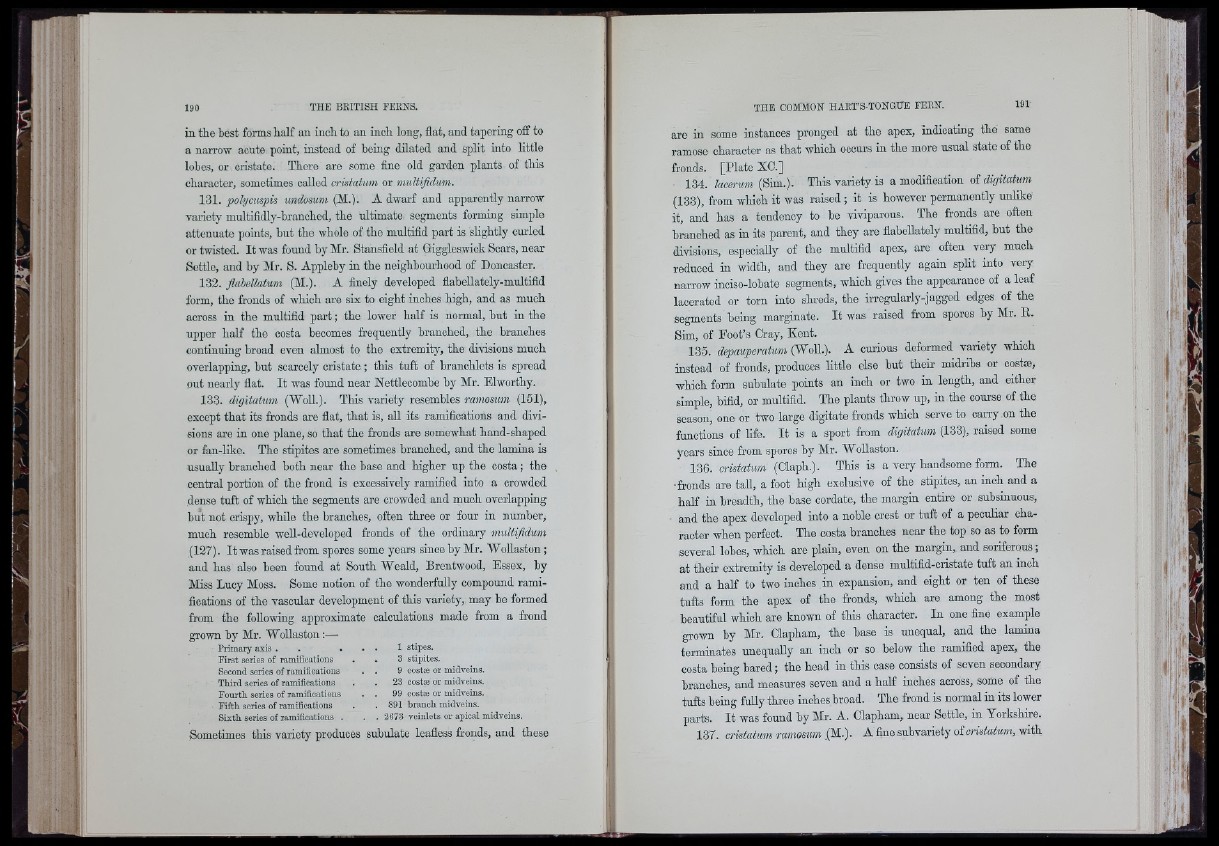
in the best forms half an inch to an inch long, flat, and tapering off to
a narrow acute point, instead of being dilated and split into little
lobos, or cristate. There are some fine old garden plants of this
character, sometimes called cristatum or muUifldmn.
131. polycuspis undosum (AI.). A dwarf and apparently narrow
variety multifidly-branchcd, the ultimate segments forming simple
attenuate points, hut the whole of the multifid part is slightly curled
or twisted. It was found by Air. Stansfield at Giggleswiok Scars, near
Settle, and by Air. S. Appleby in the neighbourhood of Doncaster.
132. flahellatum (AI.). A finely developed flahellately-multifid
form, the fronds of which are six to eight inches high, and as much
across in tho multifid part; the lower half is normal, hut in the
upper half tho costa becomes frequently branched, the branches
continuing broad even almost to the extremity, the divisions much
overlapping, but soaroely cristate ; this tuft of branchlets is spread
out nearly flat. It was found near Nettlecombe by Air. Elworthy.
133. digitatum (AVoU.). This variety resembles ramosum (151),
except that its fronds are flat, that is, aU its ramifications and divisions
are in one plane, so that the fronds are somewhat hand-shaped
or fan-like. The stipites are sometimes branched, and the lamina is
usually branched both near the base and higher up the costa; the
central portion of the frond is excessively ramified into a crowded
dense tuft of which the segments are crowded and much overlapping
hut not crispy, whilo the branches, often three or four in number,
much resemble weU-developed fronds of the ordinary multifidum
(127). It was raised from spores some years since by Air. AVoUaston;
and has also been found at South AVeald, Brentwood, Essex, by
Aliss Lucy AIoss. Some notion of the wonderfully compound ramifications
of the vascular development of this variety, may be formed
from the following approximate calculations made from a frond
grown by Air. AVoUaston:—
Primary axis .
F irs t series of ramifications
Second series of ramifications
Third series of ramifications
F o u rth series of ramifications
F ifth señes of ramifications
Sixth series of ramifications .
1 stipes.
3 stipites.
9 costæ or midveins.
23 costæ or midveins.
99 costæ or midveins.
891 branch midveins.
2 6 7 3 v e in l e t s o r a p i c a l m id v e iu s .
Sometimes this variety produces subulate leafless fronds, and these
are in some instances pronged at the apex, indicating the same
ramose character as that which oocm-s in the more usual state of tho
fronds. [Plate XO.]
134. lacerwn (Sim.). This variety is a modification of digitatum
(133), from which it was raised ; it is however permanently unlike
it, and has a tendency to he viviparous. The fronds are often
branched as in its parent, and they are flabeUately multifid, but the
divisions, especiaUy of the multifid apex, are often very much
reduced in width, and they are frequently again split into very
narrow inciso-lobate segments, which gives the appearance of a loaf
lacerated or torn into shreds, the irregularly-jagged edges of the,
segments heing marginate. It was raised from spores by Air. R.
Sim, of Foot’s Cray, Kent.
135. depauperatum (AVoll.). A curious deformed variety which
instead of fronds, produces Httle else hut their midribs or costai,
wHch form subulate points an inch or two in length, and either
simple, bifid, or multifid. The plants throw up, in the course of the
season, one or two large digitate fronds which serve to carry on the
functions of life. It is a sport from digitatum (133), raised some
years since from spores by Air. AVollaston.
136. cristatum (Olaph.). This is a very handsome form. The
■fronds are tall, a foot high exclusive of the stipites, an inch and a
half in breadth, the base cordate, the margin entire or subsinuous,
and the apex developed into a noble orest or tnft of a peculiar character
when perfect. The costa branches near the top so as to form
several lobes, which are plain, even on the margin, and soriferous;
at their extremity is developed a dense multifid-cristate tuft an inch
and a half to two inches in expansion, and eight or ten of these
tufts form the apex of the fronds, which are among the most
beautiful which are known of this character. In one fine example
grown by Air. Clapham, the base is unequal, and the lamina
terminates unequaUy an inch or so below the ramified apex, the
costa heing hared; the head in this case consists of seven secondary
branches, and measures seven and a half inches across, some of the
tufts being fuUy three inches broad. The frond is normal in its lower
parts. It was found by Air. A. Clapham, near Settle, in Yorkshire.
137. cristatum ramosum A fine subvariety oi cristatum, viiOx
■ ■ »1
■ .k r i
Vll
■' I !"l
I, I
( A
rifil
■; } é
: \ | iii
•• I'-’ V
4- rii : 1
!‘ri [.'k'll
till
m
f
'Ri
M i i i 4 l ' f
Î 'i*.J
/ Ä-.